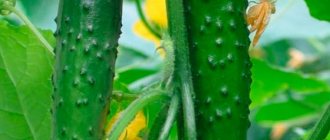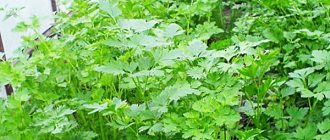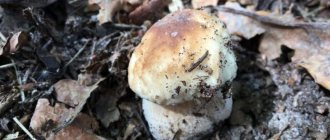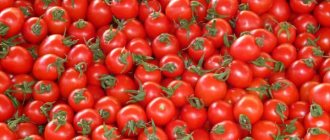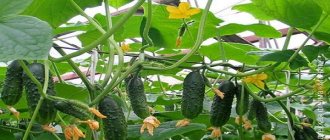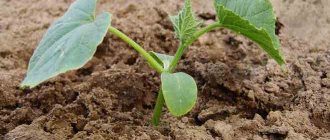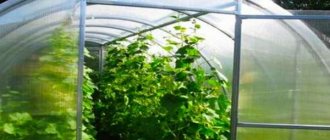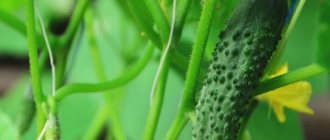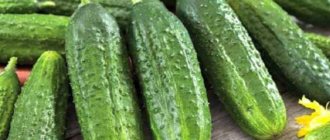Fresh cucumbers from your own greenhouse in the middle of winter - what could be tastier? With the development of modern technologies, growing vegetables in winter greenhouses is no longer a rarity. Getting fresh cucumbers to your table or for sale is quite simple. You just need to properly equip the greenhouse and follow the recommendations of experts on the choice of varieties and technology.
Growing cucumbers in a greenhouse in winter
Winter greenhouse for cucumbers: what should it be like?
So, where to start growing cucumbers in a greenhouse in winter? First of all, for winter growing you need a greenhouse on a solid concrete foundation. Structures buried in the ground have proven themselves well. The soil layer serves as additional insulation and protection; deepening allows the structure to be made less tall without limiting the plants in space.
The best greenhouses for cucumbers are built from polycarbonate, mounted on a metal frame with an anti-corrosion coating. They are not cheap, but pay for themselves in 2-3 years. Believe me, a high-quality greenhouse for growing cucumbers all year round will bring excellent results.
In addition, it requires almost no repairs; durable cellular polycarbonate does not crack under a layer of snow and can easily withstand temperature changes. It is possible to use greenhouses with tempered industrial glass, but this coating is more fragile.
The structure also needs to be equipped with windows for ventilation and curtains for shading from too hot sun.
The automatic drip irrigation system is very convenient, guaranteeing optimal soil moisture. Cucumbers love high air humidity, so do not forget about the climate control system and foggers.
It is equally important to properly organize lighting for cucumbers in a greenhouse in winter. To do this, you need powerful electric lamps with height adjustment.
A very important issue is heating. Cucumbers are a heat-loving crop that can hardly tolerate even short-term drops in temperature.
Greenhouses can be heated using electric boilers or compact wood stoves. Biofuel made from humus and straw, laid out on ridges, as well as sheets of roofing felt placed around the perimeter of the greenhouse for winter growing of cucumbers will help maintain the desired temperature.
The lower the temperature outside, the more advanced the heating system should be. In regions with particularly cold climates, it is better to use a combined technique, combining several heating methods at once.
Most often, cucumbers are planted in the ground. But in spacious industrial greenhouses, rack cultivation in 2 and even 3 tiers is also practiced. This approach makes harvesting easier and saves scarce greenhouse space.
Preparatory stage
To grow cucumbers in a greenhouse in winter, you need to choose the right variety . The process of preparing soil and seed material is of no small importance. The quality and quantity of the harvest directly depends on this.
Variety selection
For a winter greenhouse, varieties that are resistant to lack of light, low temperatures, do not require pollination, and are high-yielding are suitable. For these purposes, unpretentious early ripening parthenocarpic hybrids or special varieties for greenhouses :
- hybrids are crops bred by crossing two parental varieties: their name on the package with seeds contains the inscription F1 - these are April, Anyuta, Calendar, Zozulya, Lukhovitsky, Liliput, Makhaon, Dynamite and others;
- varieties resistant to light deficiency - Relay, Rossiysky, Regatta, Iva, Domashny, Marfinsky;
- unpretentious crops - Moscow greenhouse, Surprise, Grenade, Zarya.
Non-self-pollinating varieties require artificial pollination during the flowering period.
Soil preparation
The soil is enriched with organic and mineral fertilizers . When preparing the soil in new greenhouses, manure, potassium sulfate and superphosphate are added to the soil.
The finished substrate is infused for two weeks . Before planting plants in a permanent place, ammonium nitrate is added to the soil during loosening. To improve the quality of the soil, this event is carried out annually.
Interesting. California worms are capable of converting soil into vermicompost.
Seed preparation
To calibrate, they are placed in a saline solution for 15-20 minutes (1 teaspoon of salt per 1 glass). The seeds that float to the surface are removed - they will not sprout. The seeds that have fallen to the bottom are washed and dried.
Next, disinfection is carried out . The seeds are placed for 20-30 minutes in a 1% solution of potassium permanganate or 3% hydrogen peroxide, then washed. The procedure is carried out to increase the culture’s immunity to infectious diseases.
To harden the seeds, they are wrapped in damp cotton cloth, placed on a saucer and placed on the bottom shelf of the refrigerator for two days. Recommended temperature – from 0 to +2°С. This procedure is carried out to accelerate the emergence of seedlings and activate the immune system.
To stimulate culture growth, special preparations are used, for example, Zircon or Epin. The traditional method is also used: seeds are placed on an aloe leaf cut lengthwise overnight and planted in the morning without washing.
Photo
In the photo below: a greenhouse for growing cucumbers all year round, cucumbers in a polycarbonate greenhouse in winter.
Types of greenhouses
Greenhouses designed for growing vegetables in winter are called winter greenhouses. In terms of their functions and design, they are much more complex than conventional greenhouses and are much more difficult to build. A foundation is required for a winter greenhouse. The frame itself and the roof must be well glazed. The greenhouse must also be equipped with ventilation to ensure good air circulation. In addition, the winter greenhouse must be airtight and have a reliable heating system. Growing cucumbers in winter at home is just as profitable as in greenhouses. Greenhouses are divided by type as follows:
- Shelf-free greenhouses. In such greenhouses, plants are planted directly into the ground.
- Rack greenhouses. As a rule, this type of greenhouse is used for winter growing of vegetables. They have racks with sides, located at a height of 70-78 cm and running along the long sides of the greenhouse. A passage of at least 50 cm in width is provided between the racks.
An example of a shelving-free greenhouse with a vertical method of planting cucumbers.
Polycarbonate greenhouses are often used for the winter option for growing cucumbers.
Greenhouses for winter can also be: lean-to wall, lean-to with earth filling, gable with a roof made of greenhouse frames, gable with main walls (in such greenhouses only the roof is glazed).
In order to achieve the best yield during the winter growing of cucumbers, the following conditions must be met when building a greenhouse:
- The placement and design of the greenhouse must be correct. The best covering for a greenhouse is considered to be polycarbonate or glass. It is better to mount the frame either from a metal pipe or from a wooden beam. It is better to choose the height based on the area-to-volume ratio of 2:1. It is better to calculate the slope of the roof so that at noon the sun’s rays enter the greenhouse at an angle of 90 degrees, in which case it will be reflected less. To enter the greenhouse, it is best to attach a separate vestibule so that you can enter directly from the street. In a greenhouse for cucumbers, you cannot rely on ventilation through the windows - cucumbers do not like drafts. It would be better to make it in the form of a hood from plastic pipes.
- Heating must be comprehensive, both for air and soil. Convectors, oil heaters and metal stoves are not recommended to be placed in the greenhouse itself, because they dry out the air greatly, and cucumbers cannot tolerate this.
The greenhouse should be well lit and heated
Growing cucumbers in a greenhouse in winter: the best varieties for indoor ground
It is convenient to grow cucumbers in a greenhouse that do not produce long vines. Such plants are compact, the delicate stems are not damaged during care and harvesting. It is worth paying attention to varieties and hybrids with a short growing season that do not require pollination. There are a lot of suitable options, it is recommended to try several varieties and choose 2-3 of the most suitable ones.
- Valaamsky is a very productive early ripening hybrid, suitable for temperate and cold climates. The fruits are very tender, without bitterness, rich green in color with small black tubercles.
- Suomi is a hybrid suitable for winter cultivation and easily tolerates slight drops in temperature. The fruits are small, neat, and almost never outgrow. They have a pleasant, not watery taste.
- Bouquet is one of the earliest varieties; the hedgehog can be harvested a month after the seedlings are moved into the ground. “Bouquet” fruiting is characteristic, producing several fruits from each leaf axil.
- Sarovsky is a productive hybrid, characterized by endurance and productivity. “Bouquet” option, which gives high yields of medium-sized, even and very tasty cucumbers.
- Okhotny Ryad is an early ripening hybrid with an extended fruiting period. The fruits are small, elongated, very delicate in taste.
Care during the growing season and fruiting
Cucumbers are planted in prepared and warmed soil. To do this, prepare holes, water them and wait for moisture to be absorbed. Carefully remove the plant from the cup, place it together with a lump of earth in the hole, deepening it to the cotyledon leaves, and sprinkle it with earth.
Planting cucumbers in warm beds in a greenhouse
After planting cucumbers in a greenhouse, it is necessary to provide them with conditions for the best growth and development. Cucumbers do not like strong changes in day and night temperatures: rot of various origins appears, growth is inhibited, ovaries fall off, and the fruits become bitter. Optimal conditions for cucumbers in a greenhouse are shown in Table 2.
Table 2. Microclimate in a winter greenhouse for cucumbers.
| Parameter | Optimal values | Critical values |
| Daytime temperature, °C | 23-25 | Below 8, above 37 |
| Temperature at night, °C | 17-18 | Below 8, above 37 |
| Soil temperature, °C | 20-22 | Below 15, above 35 |
| Humidity, % | 75-80 | Below 40 |
| Illumination, lux | 10000-15000 | Long lasting below 2500 |
Watering cucumbers
The soil for cucumbers should ideally be moderately moist. This can be achieved using drip irrigation or regular watering at the root. Cucumbers are watered only with settled warm water at a temperature of 25-27°C until a ten-centimeter layer of soil is moistened. To reduce the amount of watering, the beds are mulched with sawdust, peat or straw.
Watering cucumbers from a watering can
To soften the water, you can add a minimum amount of organic fertilizer to it - 5-10 ml of mullein infusion or bird droppings per bucket of water. With this type of watering, root feeding with organic fertilizers will not be needed; the plants will receive nitrogen fertilizers with watering. Soft water is better absorbed by the roots.
The best varieties of cucumbers for polycarbonate greenhouses
The choice of varieties depends on what kind of cucumbers you plan to cultivate and what expectations you have for the future harvest. Now there are many such varieties of seeds on the market, but in order to choose the most suitable option, we recommend reading this article.
Fertilization and disease prevention
It is necessary to fertilize plants regularly - cucumbers build up a large vegetative mass and quickly consume useful elements from the soil. A lack of nitrogen affects the growth of bushes and the process of photosynthesis, a lack of phosphorus and potassium affects the shape and size of the fruit.
For feeding, use an infusion of mullein 1:5 or chicken manure 1:15. To enrich the infusion with potassium, calcium and microelements, add wood ash to the solution - a glass in a bucket. Stir the components in water and leave for two to three days.
Preparation of chicken manure solution
You can also use complex fertilizers for melons and melons to feed cucumbers. They are bred according to the instructions and watered at the root or sprayed on the leaves.
Note! When the fertilizing is infused, carbon dioxide is released from organic matter. It is beneficial for plants, so a bucket of infusion can be left in the greenhouse near the ridges.
Video - Feeding cucumbers
To prevent diseases, plants are sprayed with Fitosporin three times during the growing season with an interval of 15 days. It helps prevent the occurrence of fungal diseases. You can also use watering the soil with warm solutions of potassium permanganate and boric acid.
Spraying with Fitosporin - prevention
Forming and collecting fruits
To prevent plants from shading each other, they must be formed correctly. In greenhouses, cucumbers are grown vertically - this ensures ventilation, reduces the likelihood of diseases and makes access to the plants easier. In addition, with a vertical garter, more plants can be placed on one meter of area.
Rules for shaping cucumbers
After the plants are planted and the first flower stalks appear, the main stem is tied with twine to the supports or structures of the greenhouse. The first flower stalks are immediately torn off - they mainly consist of barren flowers, but at the same time they inhibit the growth of cucumbers. After the first side shoots appear, pinching begins according to patterns depending on the variety.
Cucumbers with a bouquet type of fruiting produce many fruits in each internode. The main harvest of such varieties and hybrids is obtained from the main stem. Their side shoots are pinched, allowing the plant to yield maximum yield.
Forming cucumbers of bouquet type of flowering
Cucumbers with a small number of ovaries in each internode are formed differently. On the fifth and sixth side shoots, one leaf and ovary are left, on the subsequent ones - two leaves and two ovaries. This way the yield will be maximized.
Forming parthenocarpic hybrids of cucumbers
Video - Forming and gartering cucumbers
After the start of fruiting, cucumbers are collected regularly, ideally daily. Even one large fruit left on the plant inhibits the setting of new cucumbers and the growth of the bush. Harvesting is carried out in the morning or evening. It is more convenient to do this after watering - this way the cucumbers prick less.
Picking cucumbers
Cucumbers from the winter greenhouse will delight you throughout the cold months. To extend the period of active fruiting, they can be planted in several stages, constantly renewing the plantings. With the right agricultural technology and selection of varieties, fresh vegetables will always be on your table.
Choosing the right seeds
Experienced vegetable growers recommend choosing cucumber seeds collected 2-3 years ago.
They have better germination, the sprouts are healthy and strong. The material prepared for sowing must be sorted out manually , removing ugly and empty seeds. Then they are disinfected by placing them for 10-12 hours in a damp cloth soaked in aloe juice or an aqueous solution of nitrophoska, copper sulfate and boric acid.
After processing, the seeds are washed, wrapped in a clean, damp cloth and moved to the lower chamber of the refrigerator. This hardening strengthens the plants and stimulates good fruiting. The seeds should remain in the refrigerator for 5-7 days, the fabric must be constantly moistened.
How much money do you need to invest to create a greenhouse?
Greenhouse farming, like any other business, requires capital investment. The purchase of greenhouses, the necessary equipment, as well as their installation on a plot of land with a total area of at least 500 m² will require approximately one and a half million rubles.
Initial investment:
- Components for the construction of greenhouses – 650,000 rubles;
- Equipment for heating the soil – 120,000 rubles;
- Heating boilers – 70,000 rubles;
- Automatic watering system – 30,000 rubles;
- LED lamps – 550,000 rubles;
- Transport costs – 50,000 rubles;
- Other expenses (seeds, fertilizer, electrical wiring, pipes) – 150,000 rubles.
Total – 1,620,000 rubles.
Annual expenses:
- Fuel – 150,000 rubles;
- Purchase of seeds – 17,000 rubles;
- Payment for electricity – 16,000 rubles;
- Fertilizer – 20,000 rubles.
Total – 203,000 rubles.
Requirements for soil and fertilizers
Cucumbers love light soil, neutral or slightly alkaline. Excessive acidity is unacceptable. The ideal soil consists of old garden soil, peat, rotted humus and river sand. Do not forget that the fertile soil layer changes annually, this is especially important when growing in shelves.
To feed cucumbers, you can alternate complex mineral and organic fertilizers, but some gardeners rely on organic matter. Cucumbers respond well to an aqueous solution of mullein or chicken droppings. The first fertilizing is carried out after the appearance of the third leaf on the seedlings, the second application of fertilizers begins during the flowering period. During fruiting, cucumbers are fed with organic matter at least 4 times.
Preparatory work with soil
In a fully equipped greenhouse, the next step is to prepare the soil for growing. This procedure takes time, so it must be carried out about a month before planting.
Ready beds with soil
Methods for soil disinfection
Before use, the soil must be cleared of weeds (their seeds) and disinfected, especially if it was taken from the garden or used to grow other crops. The easiest way is steam treatment, after which most of the pathogenic microorganisms die. More effective methods are the use of toxic substances and special preparations that require strict adherence to the instructions for use:
- Copper sulfate - 7% aqueous solution is used to treat the soil at the rate of 0.5 liters per square meter.
- Formalin is poured into narrow ditches, the greenhouse is hermetically sealed for a while, and then the windows are left open for 14 days to allow the substance to volatilize.
- Store-bought drugs - use in accordance with the attached instructions.
The treated soil can be brought into the greenhouse after 3-4 weeks.
Preparing the soil mixture
The preferred soils for growing cucumbers in greenhouse conditions in winter are sandy loam and loam, enriched with mineral and organic components. To give lightness to such a substrate, you can add a little sand or pine sawdust. The ideal mixture is a combination of turf soil and ordinary humus. Or you can make a substrate for growing based on peat, for which you take the following in appropriate proportions:
- peat – 5 parts;
- compost or humus - 3 parts;
- garden soil - 2 parts.
To enrich with minerals, add ammonium nitrate at the rate of 15 g per square meter, superphosphate - 40 per square meter, ash or potassium salt - respectively 200 g or 25 g per square meter. To impregnate the soil with fertilizers, leave it under plastic wrap for 3-4 weeks.
Tips for arranging beds
When forming beds, it is necessary to take into account the size and location of the greenhouse. Their most advantageous direction is from north to south.
Dividing a large-scale greenhouse into beds
The beds should be formed in such a way as to best distribute the space and not experience inconvenience in the future when caring for plants. First, the ground is thoroughly dug up, loosened, and then the number of ridges is determined:
- One bed in the center is easy to maintain, there is access from all sides, but the area is used irrationally.
- Two beds, separated by a central, side and transverse paths, further simplify care, but from the point of view of space planning, they are not economical.
- Two side wide beds with a single path in the center are quite good to use, the area is used efficiently.
- Three beds are the optimal solution for a wide greenhouse, especially if the bed in the center is large and the side beds are narrower.
The number of beds varies depending on the size and allocated area of the greenhouse. Wooden beams are used for marking, which will maintain the shape of the ridges. The width of the path should be at least 60 cm; it can be laid with stone, brick, paving stones or simply covered with gravel.
How to grow cucumbers in a greenhouse in winter
Cucumber seedlings can be grown in an apartment or directly in a greenhouse. the seeds in peat pots; young plants do not tolerate digging well. To obtain harvests in January, sowing is carried out in early September.
The pots are filled with the prepared substrate, the seeds are placed in holes 2 cm deep. Some gardeners plant 2 seeds in each cup, keeping in mind subsequent picking.
The soil in the pots is moistened with a spray bottle, and the top of the container is covered with glass. Another way is to cover the pots with a damp cloth. You can sow cucumbers every 2 weeks; seedlings of different ages will help ensure an uninterrupted harvest.
The optimal temperature for germination is 25 degrees. After emergence, the temperature drops to 15 degrees during the day and 12 at night. Plants need to be watered 2 times a week using water at room temperature. After feeding with mullein, it is recommended to wash the sprouts with a spray bottle.
The next stage: transplanting cucumber seedlings into a winter greenhouse. A month after sowing the seeds, the grown seedlings are moved to the prepared soil of the greenhouse. The distance between plants is 20-30 cm, between rows - about 90 cm.
conclusions
- The choice of greenhouse depends on the weather conditions in your area.
- To obtain a harvest, it is best to use cucumber varieties of Dutch selection or specially bred varieties for greenhouses, because they do not require pollination. These include the Masha F1 variety.
- During the growing process, care is important: how to pinch cucumbers, how to water them, how to fertilize them.
- With the right approach, you can then use the acquired skills in growing cucumbers in a greenhouse to implement your business plan.
Features of care after transplantation
Cucumbers are a rather demanding crop . To achieve a good harvest, you will have to carefully monitor the level of moisture and soil fertility.
For good health and rapid formation of ovaries, cucumbers need fertilizing once every 2 weeks, alternating mineral and organic fertilizers. You also need to maintain high humidity - 80-85%. To ensure such indicators, the floor and heating pipes are regularly watered.
The greenhouse itself houses open tanks. They not only humidify the air, but also settle and heat water for irrigation.
Before the flowering period , plants are watered twice a week; after the flowers appear, watering becomes more frequent and abundant.
It is important to monitor the condition of the leaves; they should be elastic and juicy. Limp, drying leaves signal an acute lack of moisture in the soil.
Light intensity is very important for winter growing. Daylight hours should last at least 12 hours. Young plants are illuminated with low-hanging lamps; as the cucumbers grow, the lamps rise higher. It is believed that the condition of plants is positively influenced by the warm light spectrum.
The temperature should not fall below 20 degrees, the optimal regime is from 25 degrees during the day to 15 at night. Ventilation should be very careful, preventing cold air from entering the plants. Cucumbers stop forming ovaries even with short-term cold snaps, and this greatly affects the yield of cucumbers in the greenhouse in winter.
Planting cucumbers
Greenhouse soil must be air- and moisture-permeable, fertile and warm. The optimal soil mixture is obtained from turf soil and humus. It is necessary to arrange a drainage layer at the bottom of the beds.
The beds should be insulated (with polystyrene foam or polyurethane sheets) or filled from below with degradable biomaterial. In the latter case, the following are used: grass, leaves, tree branches, straw, household food waste, etc. It is better to lay large branches at the bottom. They will be able to perform drainage functions. From above such a bed is filled with fertile soil.
By the time of planting seeds or seedlings, the soil should be heated to a temperature of 20 degrees. To ensure the indicators necessary for plant development (discussed above), a soil heating system should be installed. This could be a warm water pipeline or a heating cable. Before planting cucumbers, you need to prepare the soil. If the greenhouse is new, it is disinfected, fertilized and dug to a depth of about 30 cm. In a greenhouse where vegetables have already been grown, it is recommended to replace the top layer of soil (to a depth of 15 cm) with disinfection of a new one.
To reap a bountiful harvest, thickening of plantings should be avoided. It is best to plant no more than 2...4 bushes per 1 sq.m (depending on the degree of branching).
Which variety is better for business?
Every novice entrepreneur must understand that for a good yield it is necessary to choose the right variety of vegetable. Early ripening varieties are well suited for business. They ripen in a month and a half. Therefore, the harvest can be harvested more often. The following cucumber varieties germinate well:
- "Hermann"
- "Emelya"
- "Dynamite"
- "Hercules"
- "Annushka"
Usually the price for seeds is from one and a half thousand for 1,000 seeds.
Nowadays, many varieties have been developed that provide excellent productivity in greenhouse conditions. When purchasing seeds, it is better to contact reliable suppliers, preferably proven ones.
The best option would be to contact your local seed station. Then the risk of purchasing low-quality seeds will be minimal.
What documents are needed to open
If you are going to farm, then state registration of peasant farms is required, i.e. peasant farming. But this is the case when there is extensive work and large areas of land under agricultural crops (more than 1 hectare). Otherwise, the law allows you to have a personal farm (in your own backyard) and grow agricultural products for sale without taxation. To register a peasant farm, you need: an application for state registration, a passport of the founder of the company, agreements, a decision on the establishment of a peasant farm (if there are several founders). Then, confirmation of payment of the state duty and the actual place of residence of the founder. If the enterprise is founded by one person, an agreement on the establishment of a peasant farm is not needed.
Cucumbers on the windowsill: growing and care
In order for cucumbers to bear fruit well, you must follow simple rules.
A rich harvest can be obtained if you follow the recommendations for caring for plants.
Temperature and humidity conditions
The optimal air temperature for fruiting is +25°C. If the room is cold, then it is necessary to install a water radiator or an electric heater. When placing pots on the window, you need to remember that the root system suffers from a cold window sill, which has a detrimental effect on growth and fruiting. To avoid this, it is better to place a small piece of foam under the containers with cucumbers.
Oil radiators dry out the air greatly.
To increase air humidity in winter, you need to:
- Place a layer of moistened expanded clay on the tray of each pot.
- Install a humidifier on the windowsill.
- Cover the battery with wet gauze.
Lighting
In winter, there are short daylight hours, therefore, cucumbers will not have enough light. The first sign of a lack of lighting is yellowing of the leaf plate. When the first shoots appear, lighting is required from 8 a.m. to 4 p.m. To provide the plants with additional light, you need to install artificial light above the pots. Phytolamps or fluorescent lamps are suitable for this.
Lamps must be installed at a height of 15 cm from the plants. This distance must be maintained as the bush grows. When the vine reaches its limit, backlighting is done from the side. Starting from March, daylight hours increase, therefore, 4-hour artificial lighting will be enough for the bush.
In winter, cucumbers, like other greenhouse plants, require a special light regime
Disease and pest control
In order for the bush to bear a generous harvest and not get sick, it requires careful care. If you do not follow the rules of care, the cucumber bush may develop the following diseases.
Powdery mildew . A fungal disease in the form of a white coating on the leaf plate.
Most often, fungi infect the foliage of a plant.
Anthracnose. Affects leaves, flowers, ovaries and shoots.
Root rot. It affects a young plant, gradually leading to its death.
White rot . Appears as a white fluffy coating.
Treatment consists of spraying the bush with insecticides.
If treatment is not started in a timely manner, the disease quickly spreads throughout the bush.
Feeding and fertilizers
If the seeds are planted in specially prepared soil, then the bush will not need fertilizers. The exception is severe cloudy days. At this time, the cucumbers can be fed with self-prepared fertilizer, for example, from banana peels. Preparation: cut the skin of one banana into small pieces and add 1 liter of water. Let it brew for a day. Before use, the concentrate must be diluted with water.
It is also useful for cucumbers to carry out foliar feeding based on milk. For 1 liter of milk add 20 g of laundry soap and 30 drops of iodine. The bush is sprayed with the prepared solution every 10 days.
Watering rules
Cucumbers are a moisture-loving plant, and therefore watering should be regular with warm, settled water. Drying of the earthen coma by 5 cm leads to disease and death of the plant. Since the soil dries out for a long time in winter, watering is carried out only after the top layer of soil has dried.
Watering is carried out with warm, settled water.
Pinching and Garter
After the 5th leaf appears, the top must be pinched to allow new side shoots to grow. For a good harvest, only three new lashes are left. They are allowed to grow to 10 leaves, and then they are also pinched. This easy method produces a spreading bush. The whiskers must be removed as the bush grows, as they suck out a large amount of nutrients, preventing normal growth and development.
For a good harvest you need to form the bush correctly
Artificial pollination
To grow cucumbers on a windowsill in winter, you need to choose self-pollinating varieties. But if you have a favorite variety that requires pollination, you need to learn how to pollinate cucumbers at home:
- First of all, find male and female flowers on the plant. This is easy to do: the female flower has a small resemblance to a cucumber, the male flower does not.
- To pollinate, you need to tear off the petals of the male flower and carefully touch the stamens to the pistil.
- You can determine whether pollination has occurred or not by the state of the female flower; a pollinated flower will increase in size, while an unpollinated flower will dry out and fall off over time.
Artificial pollination
How to carry out pollination correctly (video):
How to calculate profit correctly
Typically, the costs of such activities pay off fairly quickly. After the first wholesale delivery, you can make a good profit. Let's try to calculate how much profit an entrepreneur will receive from one greenhouse per year:
- Let's assume that cultivation will be carried out on our own territory
- if you buy the design – 100,000 rubles
- payment for 1 worker per year – 120,000 rubles
- seeds, fertilizers, boxes, equipment – 100,000 rubles
- water, electricity, heating – 200,000 rubles
Growing cucumbers in winter at home
Planting cucumbers on a windowsill in winter does not require any specific skills or abilities. To get a rich harvest, you need to know how to properly grow cucumbers in an apartment, on a windowsill or balcony. By following simple rules, the harvest of greens will be on the table all winter.
Location
When planting cucumbers on a windowsill, you must first ensure that there are no drafts. Cold air has a bad effect on immature seedlings. It is better to choose a landing site on the south side.
Cucumbers are grown on the south side
Container for seedlings
Cucumbers can be grown either in individual pots or in a box. When planting plants in boxes, you must remember that the plant has a strong root system, so it is planted at a distance of 70 cm from each other. If cucumbers grow in a pot, then its volume should be at least 4 liters per plant.
For planting, you can use 5-liter jars
Soil requirements
Cucumbers grow only in fertile soil. You can purchase it ready-made or prepare it yourself. To do this, you need to mix in equal volumes:
- soil from the garden and forest;
- humus and sand;
- wood ash and sawdust.
Before sowing, the soil is disinfected. To do this, pour boiling water or a hot solution of potassium permanganate onto the ground. However, it must retain its nutritional properties and microelements.
It is better to disinfect the soil for garden beds in moderation.
Preparing seeds for planting
Before planting, seeds must go through 4 stages of preparation:
- The seeds are placed in a saline solution for 30 minutes. The floating seeds are removed, and those that have settled to the bottom are washed in warm water.
- The selected seed is kept in water at a temperature of +37°C for about 3 hours.
- Next, the seeds are placed in a damp cloth bag and put away in a warm place.
- After 2-3 days, after the seeds begin to germinate, they are dried and planted in a prepared container.
Sprouted seeds are a sign that you did everything right
How to plant cucumbers on a balcony or windowsill at home
Seed material must be planted in moist soil.
If the seeds are placed in dry soil, they will settle when irrigated, resulting in seedlings appearing much later. The prepared seeds are buried 1.5–2 cm, and covered with moistened soil on top. To ensure rapid emergence of seedlings, cover the container with glass or polyethylene. This is necessary to create a favorable microclimate. After the first shoots appear, the covering material is removed and proper care of the plant begins.

